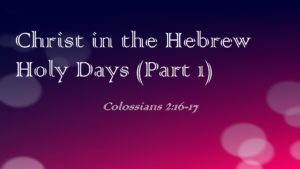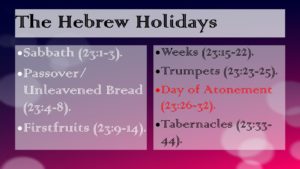Christ in the Hebrew Holy Days (Part 1)
Colossians 2:16-17
The purpose of a holiday is to help us to reflect and remember.
Every culture and every nation has their own special days that are important to them.
We just had Memorial Day to remember the fallen soldiers; Veterans Day is in the fall, reminding us of those who are still with us who fought.
The Fourth of July helps us to remember when our nation declared independence from Great Britain, and MLK Day helps us to remember a man who advocated for the civil rights of those disenfranchised in our society.
The more liturgical churches have their calendar as well to teach their people about certain important religious events of the past: Advent, Christmas, Easter – and feast days for various saints.
We are authorized in the NT to observe the first day of the week when we worship.
But the Israelites were no different.
The Israelites had various days to remember throughout the year.
Sabbath (23:1-3) – weekly observance and a day of rest.
Passover (23:4-8) – annual remembrance of the exodus from Egypt.
Firstfruits (23:9-14) – annual celebration of God’s blessings.
Weeks (23:15-22) – annual reminder of giving of the Law.
Trumpets (23:23-25) – annual day of thanksgiving for the harvest.
Day of Atonement (23:26-32) – annual national removal of sins.
Tabernacles (23:33-44) – annual reminder of their time in the wilderness.
Today we will consider the first three: Sabbath, Passover, Firstfruits.
To help us apply this, we have Col. 2:16-17.
This lets us know that these holidays were merely a shadow of things to come, that is Christ.
So as we examine these holidays, we will look for how Christ fulfills them for us as Christians.
Sabbath (23:1-3).
The Sabbath was a day of rest.
It was observed every last day of the week.
This day was chosen because this is the day the Lord rested from His creation.
They were to honor that day by resting on it as well.
The command to observe this day is enshrined in the Ten Commandments.
There were also plenty of other laws they were to follow on the Sabbath in order to observe it which we won’t get into today.
All these holidays were meant to be a “holy convocation.”
This was a day where they gathered together to worship, as on the other days.
They were to dedicate that day to the Lord (Isa. 58:13-14).
Not much else is said here on this weekly observance.
We know from elsewhere that this was a perpetual covenant between God and the children of Israel (Exo. 31:12-17).
This shows that the Sabbath was given only to the Israelites and to no other people—not even to Christians.
Christ in the Sabbath.
As we noted from Col. 2:16-17, the Sabbath, including all other Jewish holidays, were merely a shadow of things to come, fulfilled in Christ.
The Son of Man is Lord of the Sabbath, He is in charge of it (Mark 2:28).
In fact, being in Christ is the only way to find that Sabbath rest we have been waiting for (Matt. 11:28-30).
It is only through believing in Christ that we can enter into that rest (Heb. 4:3a).
In the surrounding passage, that rest is described as the Israelites entering into the Promised Land. They were not going to be able to since they rebelled against God in the wilderness.
But if you believe and do not rebel, we can enter that rest.
I mention all this because the Sabbath is then mentioned as a day of rest they could honor (Heb. 4:4-5).
Then the Hebrews writer goes on talking about a day, but not just any day, the day of the Lord, a day that now remains for us (Heb. 4:9-11).
Let us be diligent to enter that rest through obedience to His Word.
That rest is ultimately heaven that can only be reached through Christ!
Passover (23:4-8).
The Passover was a reminder of their exodus from Egypt (Exo. 12–13).
What accompanied this was the Feast of Unleavened Bread.
The Passover was established on the 14th day of the 1st month – Abib (later called Nisan).
Because they used a lunar calendar, it wouldn’t be at the same time every year for us since we use a solar calendar.
So it would likely be in April sometime, possibly as early as March—the middle of spring.
The Passover lamb was to be killed at twilight—literally between the evenings (at around 3 PM). Important later!
On the next day began the Feast of Unleavened Bread, 15-21 Abib, seven days.
During this feast, the only bread they were to eat must be free of yeast or any other leavening agent.
They were to make sacrifices every day, but on the 15th and the 21st they were to gather together, a holy convocation, similar to the Sabbath (no work).
It was a reminder of God’s deliverance and their swift exodus from Egypt, but also their drive to be holy.
Leaven was often considered symbolic of corruption and sin and was to be purged from their homes. This was that reminder to be righteous and holy.
Christ in the Passover.
A few months ago we looked at Christ in the Day of Atonement (Lev. 16).
As we saw with all the sacrifices early on in Leviticus, Christ also is the fulfillment of all of this Jewish holidays.
The Passover represents the deliverance of the Israelites to Egypt—Christ’s sacrifice is the point at which we all had the opportunity to be completely delivered from sin.
His sacrifice was made on the cross the very day before Passover (John 19:14), and He died at the 9th hour—3 PM (Mark 15:33-34, 37)—between the evenings.
Paul tells us exactly how Christ is our Passover (1 Cor. 5:6-8).
He likens sin to leaven, and that a little bit of sin affects the whole congregation and should be purged.
That is because Christ is our Passover when He sacrificed Himself for us.
This is in the context of a man who was caught in a sexual sin to be delivered to Satan (by withdrawing fellowship) so he might repent.
That old leaven was to be purged, along with the leaven of malice and wickedness. Holiness abhors such traits!
Instead we are to adopt sincerity and truth—a formula we should always adopt, to be sincere in our adherence to the truth, His truth! (John 8:32; 4:24).
Firstfruits (23:9-14).
This was an offering of thanksgiving and a reminder that everything belongs to God.
This occurred at the time of the barley harvest, the first harvest of the year.
Of course this was only after the Israelites entered into the Promised Land when they had fields to grow barley.
The first sheaf that was harvested was to be offered to the Lord via the priests.
They were to take it and make a wave offering.
Recall, the wave offering was when they waved it in the air, likely in the shape of a cross.
Also recall that we talked about some of the particulars of this all the way back when we looked at Leviticus 2 and the grain offering.
This was the firstfruits—they were not to eat of the harvest at all until the Lord received His portion.
The timing by the time of Jesus was up for debate: the Samaritans and Sadducees believed it was meant to be on the Sunday after the Passover; the Mishna (which likely meant the Pharisees) and other contemporary historians believed it was always on 16 Nisan, the day after the first day of the Feast of Unleavened Bread.
This comes from the different understandings of the word “Sabbath.”
It could mean, as we saw in 23:3, the last day of the week.
Or it could mean the day that they did no customary work—in this case 15 Nisan.
The most plain reading lends to the former, that it is the first day of the week.
I think this is also supported theologically in the NT, which we will get to.
Whatever the case, this was an offering of thanksgiving and praise, not an offering
to curry favor as with the pagan deities of that time.
And it was offered during the Feast of Unleavened Bread.
Christ is the Firstfruits.
Of course, we should be generous with our giving, recognizing that all that we have really belongs to God. We are only giving a little of it back.
The idea of firstfruits exists in several places in the NT, but none as important as the resurrection of our Lord (1 Cor. 15:20).
Through Him, we have the promise of a resurrection one day as well.
Christ died on Passover, but He was raised on the day of the Offering of the Firstfruits!
I’ve noticed some debate in when Jesus died, Thursday or Friday, and different ways on how they counted how long He was in the grave.
But we know He arose on the first day of the week, as it is made clear in every gospel account.
This was most assuredly the day after the Sabbath of the Passover.
Christ, having risen from the dead, assures us that we have a resurrection waiting for us! (1 Cor. 15:20-28).
Because of Him, we know that all that we just read will come to pass:
In Christ all shall be made alive.
Christ raised first (firstfruits), then all of those in Christ (His church) when He comes again.
All His enemies will be destroyed and made subject to Him, even death.
All this we see in the offering of the Firstfruits.
Conclusion.
In all three that we looked at today, we see elements of Christian worship.
The Sabbath is represented through the weekly worship we observe.
The Passover and Unleavened Bread are shown in the Lord’s Supper.
And the Firstfruits are given when we offer monetary gifts in the contribution.
The next three (or four) holidays.
Next week we’ll look at the Feast of Weeks, the Feast of the Trumpets, briefly at the Day of Atonement, and finally the Feast of Tabernacles.
The Feast of Weeks is closely related to the ones we looked at today, but I wanted to keep it even—3 today, 3 next week.
Since we already covered the Day of Atonement pretty well a few weeks ago (Lev. 16), we will only briefly touch on it next time.
So in all these holidays, we see the shadow of Christ and how He fulfilled them all.
In Christ there is perfect rest.
He is the Passover Lamb that has delivered us from our bondage to sin.
And He rose again as the firstfruits, letting us know that, while He was the first, He won’t be the last!
Recall that the only way to enter into that rest is through Christ.
We are to be diligent to enter that rest (Heb. 4:11).
We should work out our own salvation with fear and trembling (Phil. 2:12).
Not that we can earn it, since it is by grace through faith (Eph. 2:8-9).
But it is not a lazy person’s religion.
Let us enter Christ by believing in Him, repenting of our sins, and being baptized in Christ
Only then can we enter into His rest (Gal. 3:27).
Will you obey Him today?

